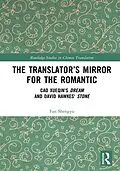The Translator's Mirror for the Romantic: Cao Xueqin's Dream and David Hawkes' Stone is a book that uses precious primary sources to decipher a master translator's art in Stone, a brilliant English translation of the most famous Chinese classic novel Dream.
This book demonstrates a bilingual close reading which sheds light on both the original and its translation. By dividing the process of translation into reading, writing, and revising, and involving the various aspects of Sinological research, textual criticism, recreation, and literary allusions, this book ventures to emphasise the idea of translation as a dialogue between the original and the translated text, between the translator and his former self, and a learning process both for the translator and the reader of his translation.
Any student of Chinese language and literature, or Chinese-English translation, will benefit from this book; for students and scholars who want to study David Hawkes and his Stone, this book is an indispensable aid. Readers will be interested to see how a non-theoretical analysis could be used to evaluate this translation, for it makes an extremely important and useful contribution to this subject.
Autorentext
FAN Shengyu is a Senior Lecturer in Chinese studies, School of Culture, History and Language at the College of Asia and the Pacific, Australian National University.
Klappentext
The Translator's Mirror for the Romantic: Cao Xueqin's Dream and David Hawkes' Stone is a book that uses precious primary sources to decipher a master translator's art in Stone, a brilliant English translation of the most famous Chinese classic novel Dream.
This book demonstrates a bilingual close reading which sheds light on both the original and its translation. By dividing the process of translation into reading, writing and revising, and involving the various aspects of Sinological research, textual criticism, re-creation and literary allusions, this book ventures to emphasize the idea of translation as a dialogue between the original and the translated text, between the translator and his former self, and a learning process both for the translator and the reader of his translation.
Any student of Chinese language and literature, or C-E translation will benefit from this book, for students and scholars who want to study David Hawkes and his Stone, this book is an indispensable aid. Readers will be interested to see how a non-theoretical analysis could be used to evaluate this translation, for it makes an extremely important and useful contribution to this subject.
Inhalt
Contents
List of Figures
Preface by John Minford
Some Words Before the Curtain
Prologue: the Hawkesian World
- "Profound Scholarship and Patient Research":
- 'To Change, or Not to Change, That is the Question':
- "Comes to Life on the Page":
- "So Much Ink Splashed for Fun":
- "The Key to Good Translation is Revision":
- "Little Private Jokes":
Sinology as Foundation
Construction of Base Text
Sound, Shape and Style in Translation
Playfulness and Imagination
Manuscripts, Notebooks and Typescripts
Western Literary Allusions in a Chinese Novel
Epilogue: "A Text that Rumbles with Echoes and Reminiscences"
Bibliography
Index
